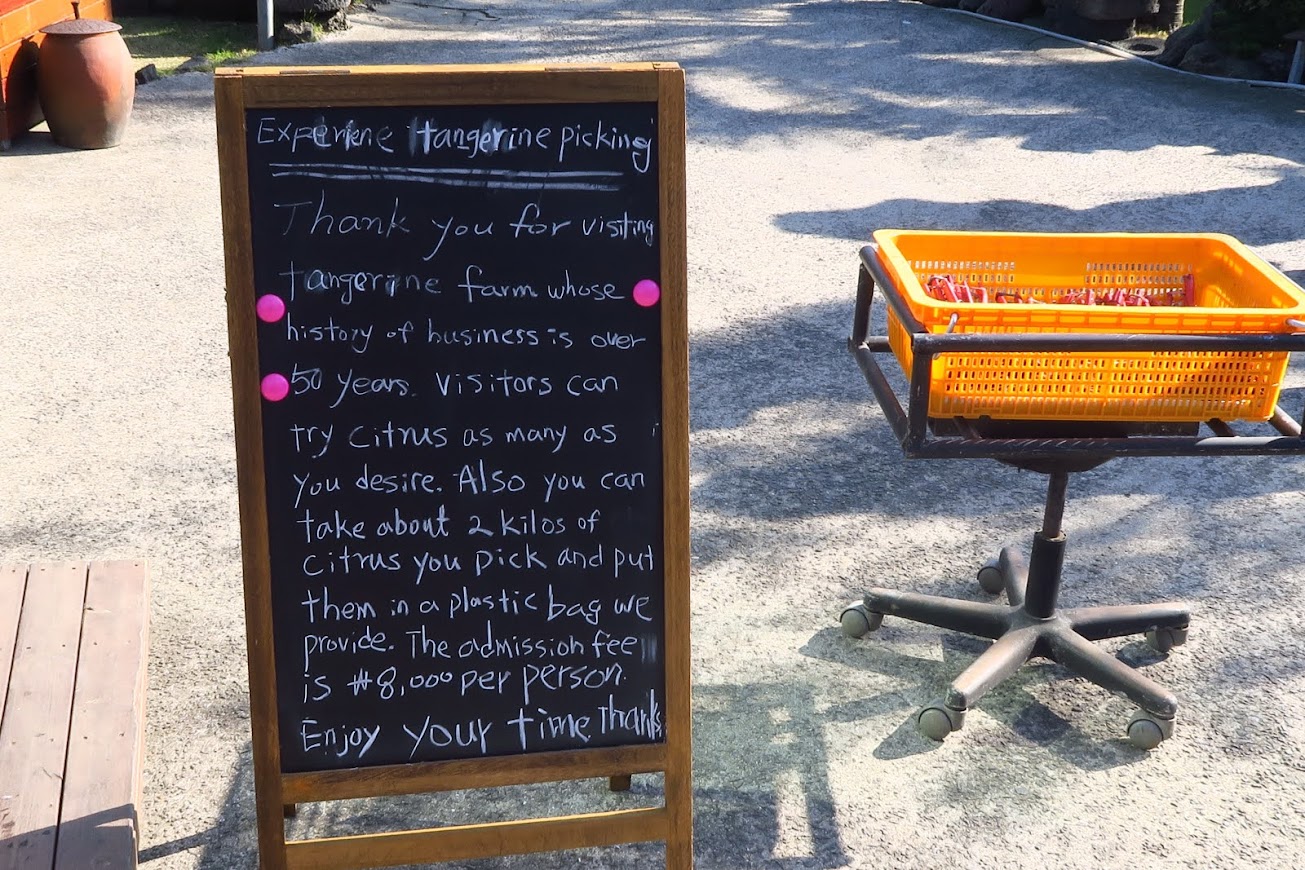9 November 2022
The king of fruit in Jeju would be the mandarin orange or tangerine. We saw many stalls selling these fruits at Dongmun Market and also many souvenir stalls selling bright orange-coloured hats. The tangerine is hence a truly iconic fruit of Jeju Island and is well renowned for its superb taste. In fact, 95% of the Korean tangerines that are enjoyed both locally and internationally are actually produced in Jeju Island.
Tangerine picking is a great outdoor activity that both the young and old can enjoy. There are numerous farms all over Jeju that grow the fruit and some farms allow visitors to go pick their fruits for a small fee. We get to taste the fruits while picking and also get to bring some back home.
We went to farm near to Jeju City called Odeungdong Tangerine Farm in the morning.
Address: 8-15 Odeung 14-gil, Jeju-si.
This farm charges 8,000 KWR per person. We get to eat as many as we desire and we get to bring home a bag of oranges (about 2 kg).
Upon registration with the lady staff at the farm, we were each given a cutter and a small plastic bag. The staff led us to the orange grove where she showed us the correct way to cut the fruits off the branches.
Jeju oranges are very easy to peel. The staff told us to throw the peels below the tree, next to the trunk. This would be natural compose for next season’s growing.
Once done, she went off and we had to whole orchard to ourselves. We went around the orchard like a bunch of excited school kids on a field trip. Snipping, peeling, tasting. Repeat.
Orange trees are actually low shrubs and the fruits are easily within reach, without need for a ladder. “Picking low hanging fruits”, a term we used to say in the corporate world.
Orange grove with many fruit laden shrubs. We were the first group of visitors at this farm on this day.
Our game plan was to taste oranges from as many trees as possible. Once we identified the trees that have good tasting fruits, we can concentrate on picking our fruits from those trees. This was based on our assumption that the same tree would produce same tasting fruits. We may be wrong!
Cut about 1 inch from the fruit, with or without a few leaves. Then cut away the stalk.
There are a few varieties of tangerine or mandarin orange in Jeju. The most well known one would be the unique Hallabong. It has a little bulb on top that resembles Hallasan, hence its name. The harvesting season for Hallabong is December to February.A green Hallabong orange that is not ripe for picking.
Visitors get to pick different variety of tangerine at farms, depending on the month of visit. In November, the tangerines that we got to pick at the farm are the Hwanggeumhyang translated as “golden fragrance”. This variety of orange contains less sugar (hence less sweet) but is very juicy.
From January to April, the farms would have Cheonhyehyang, translated as “the scent that reaches heaven”. Besides the fragrance, Cheonhyehyang tangerines contain less acidity and a rich sweetness.
The Hwanggeumhyang variety at this farm. Harvesting season is from July to January.
All the oranges we picked at this farm are seedless and have a very thin peel. There is also this nice citrus fragrance when we peeled the oranges.
Our harvest to bring along with us.
Odeungdong Farm also has a very beautiful garden for us to relax and enjoy the fine Jeju weather on this day.
The Old Grandfather stone or Dol Hareubang is commonly found all over Jeju.
There is also a spot just outside the toilets where I could take a photo of myself using the reflections from well-placed mirrors.
Cool!
I am not sure if the placement of the mirrors was intended for this effect.
Beside tangerines, this farm has many other fruits trees that are worth a look.
Persimmons that is common in Korea.
Tree with many pomelos.
Close-up photo of the pomelo which is much larger than an orange.
An interesting citrus fruit known as “Buddha’s Hand” or the fingered citron.
A photo of the pomegranate plant with fruits taken while my travelling group is walking out to our chartered taxi.
For city dwellers like us, a visit to a farm to pick tangerines was quite a fun and memorable activity. Jeju oranges are very nice to eat too.
The only bad thing that happened at the farm was that one of our travelling companions slipped, fell and injured her foot while in the farm. And she had to miss this fun activity and lots of other activities later on in this trip too.








































 Golden statue of the Maitreye Buddha.
Golden statue of the Maitreye Buddha. A hill behind the golden buddha with rows of small statues and silvery grass.
A hill behind the golden buddha with rows of small statues and silvery grass.











